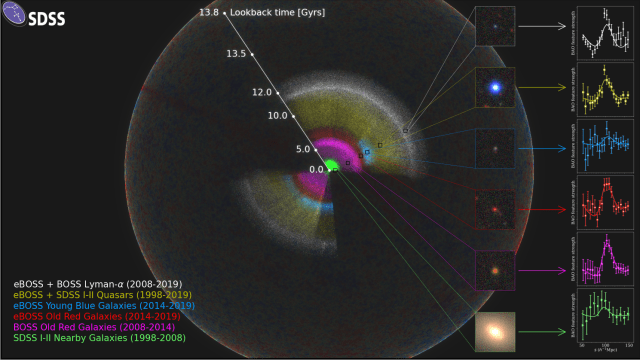An international consortium has compiled the most comprehensive 3D map of the observable cosmos to date, significantly improving our understanding of cosmological history while raising new questions about the fundamental laws that govern the universe.
The updated map, made from data gathered by the Sloan Digital Sky Survey (SDSS), offers a detailed history of the cosmos, from the Big Bang and its early expansion phase through to the current era.
The latest phase of the project, called “extended Baryon Oscillation Spectroscopic Survey” (eBOSS), includes the positions and distances of more than 4 million galaxies and ultra-bright quasars surrounding supermassive black holes, according to a press release from EPFL, a Swiss research institute. The new results are showing how the universe evolved over an 11-billion-year period, filling an important gap in our knowledge.
“In 2012, I launched the eBOSS project with the idea of producing the most complete 3D map of the Universe throughout the lifetime of the Universe, implementing for the first time celestial objects that indicate the distribution of matter in the distant Universe, galaxies that actively form stars and quasars,” Jean-Paul Kneib, a co-leader of the project and an EPFL astrophysicist, said in the press release. “It is a great pleasure to see the culmination of this work today.”
The eBOSS project has resulted in 23 new scientific papers (plus the new map), which were released today to the arXiv pre-print server.
Astrophysicists have previously chronicled the earliest days of the universe by calculating the abundance of elements created after the Big Bang and studying the Cosmic Microwave Background Radiation — the cooled remnant of the universe’s first light. Scientists also have a good handle on recent cosmological history, as informed by galactic maps and distance measurements. But “there’s a troublesome gap in the middle 11 billion years,” said Kyle Dawson, a cosmologist at the University of Utah and the principal investigator of eBoss, in an SDSS press release.
To gaze back at this 11-billion-year gap, the scientists honed in on galaxies and quasars, looking for patterns in how they’re distributed across the universe. These observations were then combined with data gathered during previous phases of SDSS, dating back to 1998.
“Taken together, detailed analyses of the eBOSS map and the earlier SDSS experiments have now provided the most accurate expansion history measurements over the widest-ever range of cosmic time,” Will Percival, an astrophysicist at the University of Waterloo and eBOSS’s Survey Scientist, said in the EPFL statement. “These studies allow us to connect all these measurements into a complete story of the expansion of the Universe.”
The updated map shows empty voids and filaments that defined the universe a mere 300,000 years after the Big Bang, which happened 13.8 billion years ago. By identifying ancient quasars — extremely bright galactic cores surrounding supermassive black holes — the researchers were able to map regions more than 11 billion years old. To map more recent periods, namely regions between 6 billion and 11 billion years old, the scientists tracked patterns in the distribution of galaxies, which subsequently enabled more accurate measurements of dark energy.
“One of the things we want to learn about is the time evolution of dark energy — this mysterious thing that is causing the universe to accelerate,” Ashley Ross, a project scientist and researcher at Ohio State University, told Ohio State News.
According to the new data, the universe entered into its accelerating expansion phase some 6 billion years ago, and it has been speeding up ever since.
Interestingly, the new eBOSS data is complicating our understanding of the rate at which the universe is expanding, known as the Hubble Constant. There appears to be a discrepancy between the local (i.e. recent) rate of universal expansion compared to the early universe, which differs by as much as 10%. It’s “unlikely that this 10% difference is random due to the high precision and wide variety of data in the eBOSS database,” according to the EPFL.
It’s not immediately clear why there should be a difference in the expansion rate between the local and early universe, but it might have something to do with an unknown form of energy or matter that existed back then.
This now represents a tantalising possibility that will have to be explored by future research. This may be the most comprehensive picture of the universe to date, but it’s another reminder of how much there still is to know.
Editor’s Note: Release dates within this article are based in the U.S., but will be updated with local Australian dates as soon as we know more.
